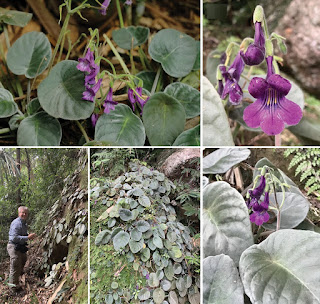 |
| Chayamaritia vietnamensis F.Wen, T.V.Do, Z.B.Xin & S.Maciej in Xin, Fu, Maciejewski, ... et Wen, 2021. |
Abstract
Chayamaritia vietnamensis, a new species from Son La Province, northern Vietnam, is described and illustrated. The phylogenetic study revealed that the new species is most closely related to C. banksiae and C. smitinandii. The morphological comparison suggests it as the third new species of Chayamaritia and distinguished from C. banksiae and C. smitinandii by a combination of morphological characters of leaf blades, bracts, calyx and corolla, especially its peltate leaf blades. This species is provisionally assessed as endangered (EN B1ab(iii), B2ab(iii)) using IUCN Categories and Criteria. Information on ecology, phenology and an identification key for the known Chayamaritia species are also provided.
Keywords: Cliff-dwelling, Flora of Vietnam, new taxon, taxonomy
Chayamaritia vietnamensis F.Wen, T.V.Do, Z.B.Xin & S.Maciej, sp. nov.
Diagnosis: The new species can be easily distinguished from the known Chayamaritia species by its peltate leaf blades. Besides, it differs from C. banksiae by its leaf blades apex rounded and margin entire (vs. apex shortly acuminate and margin minutely dentate); bracts 3, apex rounded and margin entire (vs. 2, apex acuminate and margin dentate); calyx lobes inside glabrous and margin entire (vs. inside with white appressed hairs in upper half, margin coarsely dentate); corolla lobes margin entire (vs. margin being minutely dentate); lateral staminodes 2.5–4 mm long (vs. 5.5–11 mm long). It also differs from C. smitinandii by its leaf blades apex rounded and margin entire (vs. apex acuminate and margin minutely dentate); bracts 3, ovate narrow and apex rounded (vs. 2, narrowly elliptic to lanceolate, somewhat falcate, apex acuminate); calyx lobes inside glabrous and margin entire (vs. inside densely pubescent, margin slightly toothed or appearing as large sessile glands on margin).
Etymology: The specific epithet “vietnamensis” is derived from Vietnam, which holds the first discovered and only known location for the species.
Distribution and habitat: Chayamaritia vietnamensis is hitherto only known from the type locality, Xuan Nha Nature Reserve, Moc Chau District, Son La Province, northern Vietnam. It grows on rock surfaces surrounded by limestone areas in a subtropical evergreen seasonal rain forest.
Zi-Bing Xin, Long-Fei Fu, Stephen Maciejewski, Zhang-Jie Huang, Truong Van Do and Fang Wen. 2021. Chayamaritia vietnamensis (Gesneriaceae), A New Species from Son La Province, northern Vietnam. PhytoKeys. 177: 43-53. DOI: 10.3897/phytokeys.177.63401





